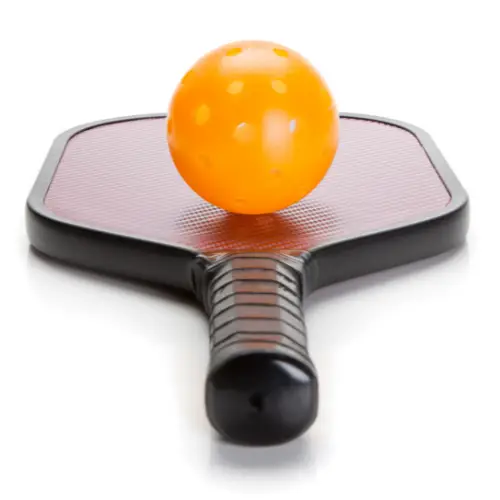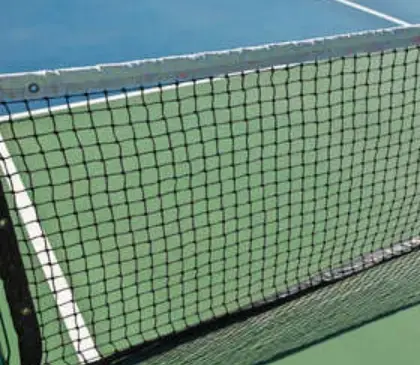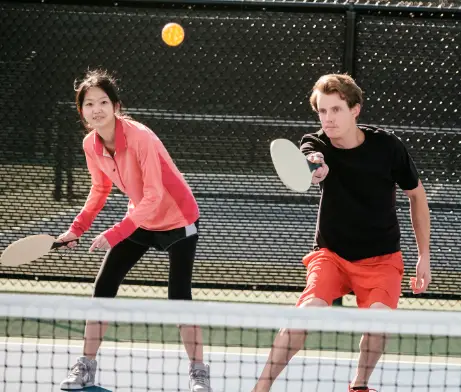A pickleball lob shot, also known as a high lofted stroke, is a shot intended to propel the ball high and deep so that it falls in the back of the court, over the opponent.
The lob is a lofted stroke that propels the ball far overhead and deep, according to the USA Pickleball definition.
In pickleball, it can be a shot that is particularly effective. This stroke can be used by a pickleball player when their opponent is near the net and positioned at the non-volley zone line.
Pickleball shots that place your opponent in a defensive posture and move them away from the non-volley line, also known as the kitchen, are beneficial because they offer you more time to prepare for your next shot.
What Are Different Types Of Lob Shots?
A pickleball lob shot is a high lofted shot that is often made with an open paddle face in order to either drive your opponents off the non-volley line (offensive) or buy yourself some extra time while the ball is still in the air so you can get ready for your next shot (defensive).
- The Offensive Lob
When your opponents are positioned near their own non-volley line and are leaning a little too far forward in expectation of an impending dink shot, you can use the offensive lob as a surprise tactic to score.
- Defending Lob
The defensive lob is a lob shot with the intention of purchasing time to rejoin the rally, as opposed to the attacking lob. Here are a few situations in which you would wish to launch a defensive lob:
- Simply trying to get a paddle on the ball so you have time to make the next shot, you are stumbling from side to side.
- Because you’re moving forward quickly after your opponent hits a short shot (while you’re back on the court), it’s likely that you won’t be able to control the next shot into their non-volley zone. A lob might be highly useful in this situation.
- Your opponents have lobbed you, making it impractical for you to drop a shot into their non-volley zone. It might make sense to throw a lob in this situation.
How To Hit An Offensive Lob
It is best to launch an aggressive lob from a few millimeters behind the non-volley line. The lob should typically be hit over your opponent’s backhand, which is the shoulder that doesn’t have a paddle. Additionally, the offensive lob should only be used in response to a pointless (dead) dink from your adversary.
The method for hitting the lob is nearly the same as that for the dink shot in terms of technique:
- Soft, relaxed continental grip (hammer grip)
- Minimize/eliminate your backswing
- Stay low with your knees slightly bent
- Make contact in front of the body
- Lift/push out-and-up (you want the ball to barely go over your opponent’s outstretched arm and land deep in the court)
A fantastic job will be distinguished from a good lob by disguise. Make the lob resemble a dink to effectively mask the shot. Nothing you do should “inform” your opponent what shot you are about to take. Don’t, for instance, stand tall. Avoid moving backward. These are some of the more frequent “tells” that “give away” your shot, in my experience working with pupils.
When Is The Offensive Lob A Smart Shot?
When you see your opponent leaning forward at the non-volley zone line, almost as though they are expecting a dinked ball, it is advisable to use an offensive lob shot. It’s a terrific opportunity to make a lob shot.
The best conditions for using an offensive lob are when:
- Because of this well-placed lob shot, your opponent, who is not particularly swift on the court, will have to react quickly.
- With the wind, you’re striking. You may direct your lob deep into the court by using the wind. If you decide to utilize it, it’s critical to accurately assess the wind and avoid overhitting.
- When nature blocks your adversaries’ path. They may find it challenging to see a ball overhead due to the sun or shadows.
- The overhead shots your opponent makes are not very accurate. The worry that your opponent will hit you with a strong overhead smash is one of the main drawbacks of using a lob. But many newcomers and intermediate players find it difficult to make a solid overhead. If your opponent has a weak overhead smash, you should lob.
- The player you are up against is smaller. A shorter player often finds it more difficult to return a lob. A taller player finds it simpler to return a lob shot, despite the fact that the contrary is also true.
Use caution when repeatedly using the log, especially if your play is recreational and enjoyment is a top focus. Due to physical and skill restrictions, many players can’t handle a lob, and if lobs are utilized on every point, the game may become monotonous for everyone.
Use caution when repeatedly using the log, especially if your play is recreational and enjoyment is a top focus. Due to physical and skill restrictions, many players can’t handle a lob, and if lobs are utilized on every point, the game may become monotonous for everyone.
How To Defend A Lob Shot?
There are a few things you can do to improve your chances of hitting the ball when defending against a lob.
- Hit the Ball Out of the Air
Your first move becomes crucial as soon as the lob starts to sail over your head. You need to pivot with one foot and run back, being careful not to cross your feet, rather than backpedaling and maybe harming yourself. Imagine your body as a gate, and your rear foot as the key that unlocks the gate.
You will have the best chance of getting back far enough under the ball to smash it out of the air if you do this since it will prevent you from twisting up your feet and possibly falling. Once the ball has bounced, getting it back is significantly more difficult.
- You Can Choose From 3 Return Shots
Let’s say you return there and are in a position to fire a shot. You’ve got three choices.
- Powerfully drive the ball back (offensive)
- Back it off (defensive)
- Drop fired back (defensive)
You must pick what to do with the ball as soon as possible, but most of the time you should select a defensive shot that gives you time to return to position and attempt to build up a point later in the rally. It’s incredibly challenging to score from this position, therefore it’s frequently preferable to aim to simply make a strong, solid shot on the ball to continue the round.
The lob shot is an effective play because it puts your opponent in a precarious position.
- Make It Impenetrable
The final objective, regardless of the shot you select, is to render it invulnerable. If you softly return the ball and they easily score after doing so, it won’t help you or your squad much. Instead, go deep into their court or for the sides. You probably won’t be able to keep them from your retreating shot, but you can hinder your opponent’s access to your subsequent shot.
- Return to your position
You’ve successfully retreated and returned their scoring lob attempt, so kudos to you. What’s next? Back up at the NVZ line or halfway between the line and the back is an excellent place to start. We see people appreciating what they’ve just accomplished all too frequently as they sit back at the baseline in an awkward stance.
Congratulations on receiving the return, but keep in mind that there is still work to be done.
You are there! Both four effective lob usage strategies and four defensive lob play strategies are provided. These pointers ought to help you win more games and irritate your opponents into submission.
Conclusion
If done correctly, the pickleball lob shot is incredibly useful from both an attacking and defensive standpoint. Don’t forget to include it in your game. But be careful not to overdo the lob, especially if you’re not hitting it for a specific reason.







